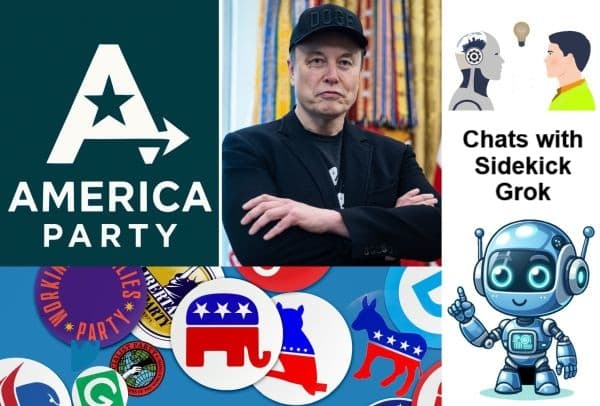
The idea of a Musk America Party has been floating around political discussions lately, so I decided to chat with my AI sidekick Grok about what Elon Musk’s political party might actually look like. Consulted with Grok, xAI’s incisive AI assistant, to unpack Elon Musk’s proposed “America Party” and its viability for the 2026 midterms. Musk’s ambition to disrupt the two-party system is a bold claim, so I posed two pointed questions to Grok to gauge the party’s progress and explore a strategic alternative to running candidates. For perspective, I also asked ChatGPT the same first question, and its data-driven take—especially the 10–15% support figure—adds a sharp contrast. Here’s our exchange, with my questions, Grok’s analysis, and how it stacks up against ChatGPT’s view.
Question 1: Is the America Party Gaining Traction?
My Question: “Any movement with the creation of an ‘America Party’? Will it be up and running by 2026 midterms?”
I asked Grok if Musk’s America Party is moving beyond X posts and whether it’ll be operational by the 2026 midterms. A new party is a tall order—can it take shape in time?
Grok’s analysis of a potential Musk America Party: As of July 2025, Elon Musk announced the America Party after sparring with Trump over a $3.3 trillion budget bill, slamming its deficit impact. An X poll showed 65% support for a new party to challenge the “uniparty.” With a platform of fiscal restraint, free speech, and limited government, the party aims to target 2–3 Senate and 8–10 House seats in 2026 to disrupt the two-party system. Yet, it’s not registered with the FEC, and organizing is a logistical challenge. Ballot access requires thousands of signatures per state, and voter loyalty to Democrats and Republicans is a steep barrier. Musk’s wealth and X’s reach could enable a limited campaign by November 2026, but Grok predicts it’s more likely to split Republican votes, potentially aiding Democrats, per recent polls. A fully operational party by the midterms is a long shot.
Comparing Grok and ChatGPT on the America Party
I also asked ChatGPT about the America Party’s traction, and it offered a sobering perspective. Citing a Quinnipiac poll, it noted that while half of voters are open to a third party, 77% wouldn’t back Musk’s America Party, with only 17% showing support (americapartypolitcalparty.com, The Daily Beast). Another analysis suggests that if the party runs candidates, it could siphon Republican support, dropping GOP congressional polling from 48% to 41%, with 5% for the America Party, potentially tipping races to Democrats (The Daily Beast). Experts estimate national support at just 10–15%, which caught my eye as a sign of limited but notable interest (CBS News, El Pais, News.com.au). ChatGPT also highlighted the difficulty of third-party formation due to complex state ballot access laws and legal pushback from major parties, noting Musk’s inability to run for president due to his citizenship but his potential to fund candidates via a Super PAC. The feasibility of a Musk America Party depends on a lot to happen before 2026 midterm. Grok is slightly more optimistic about Musk’s resources enabling a 2026 presence, emphasizing his X poll and targeted strategy, while ChatGPT underscores low public support and structural barriers, seeing the party as more talk than action.
Question 2: Influence Over Competition?
My Question: “Why bother fielding candidates that probably can’t win anyway. Instead, work on what the DEM and REP candidates are running on, and see if you can get one to agree to include the America Party’s agenda—at least on 2-3 main points?”
Skeptical of third-party wins, I asked Grok if the America Party shouldn’t push Democratic or Republican candidates to adopt its core ideas, like fiscal discipline or free speech, rather than running doomed campaigns.
Grok’s Take: Grok deems this a strategic pivot, avoiding the risks of third-party campaigns that could split votes (e.g., hurting Republicans, per a July 2025 Echelon Insights poll). Building a party—securing ballot access, recruiting candidates—is resource-heavy with slim win odds in the two-party system. Instead, Musk could leverage his X platform and wealth ($200 million spent on Trump’s 2024 campaign) to pressure candidates in 2026 races to adopt America Party priorities: cutting deficits, protecting free speech, and reducing government overreach. Targeting primaries, where candidates seek differentiation, is key. Republicans, especially libertarian-leaning ones, might embrace fiscal restraint; moderate Democrats in swing districts could adopt deficit reduction to appeal to centrists. Musk could amplify this through X posts, ads, or Super PAC funding, focusing on tight races like Senate seats in Pennsylvania or Nevada. Challenges include Musk’s polarizing persona and the need for detailed policy proposals. Grok sees securing commitments from 2–3 candidates by late 2025 as achievable, using Musk’s influence to shape platforms without running candidates.
Why This Matters
This dialogue with Grok, contrasted with ChatGPT’s data, highlights the America Party’s uphill climb. The two-party system, dominant for over 160 years, is a fortress—third parties rarely break through. ChatGPT’s 10–15% support figure suggests a niche but limited base, reinforcing my second question: why fight a losing battle when you can influence major players? Musk’s X reach and financial clout could shift policy debates in the competitive 2026 midterms, where small margins matter. Grok’s focus on Musk’s disruptive potential feels more actionable than ChatGPT’s emphasis on low support and barriers, but both underscore the need for strategic focus.
Conclusion
My chat with Grok illuminated the America Party’s nascent state as of July 2025. Whether a Musk America Party becomes reality or remains speculation – Musk’s vision is ambitious, but ChatGPT’s polling data—especially the 10–15% support—shows limited traction, with structural hurdles like ballot access looming large. Running candidates risks vote-splitting; influencing major-party candidates to adopt fiscal restraint or free speech is savvier. Grok’s optimism about Musk’s resources contrasts with ChatGPT’s caution, but both agree the party’s not yet ready. With 15 months to the 2026 midterms, Musk’s X influence and cash could sway a few candidates in key races, provided he sharpens his policy pitch. Follow Musk’s X posts or FEC filings at https://www.fec.gov/ for updates. This could be the start of a series—can Musk reshape politics?
